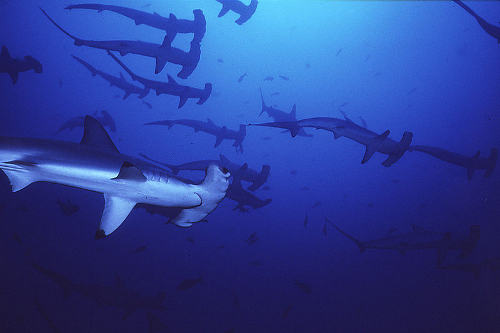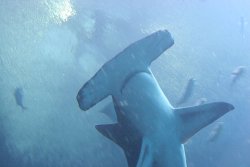The Hammerhead Shark Family
Sphyrnidae
Thanks to their odd shaped heads, the Hammerhead Shark family, or Sphyrnidae, are probably one of the most recognised fish in the sea.

There are 9 recognised species in 2 genera.
|
|
These sharks are often seen in schools during the day but go off alone to hunt at night.
Fascinating Hammerhead Shark facts:
Hammerheads tan! Marine biologists Chris Lowe and Gwen Goodman-Lowe, from the University of Hawaii, noticed that the hammerhead pups they had moved from murky waters to the clear waters of their research pool were changing colour.
Some sharks have the ability to change colour in a similar way to the chameleon in order to blend in with their environment, but these pups were going darker even though the bottom of their pool was white sand.
The Lowes did an experiment where they placed an opaque covering over the dorsal fin of of some newly transferred pups. Sure enough, over time, the pup's colour darkened, and when the covering was removed the dorsal fin was as pale as it had been when the animal was originally caught.
It's known that some fish get sunburn, but the hammerhead is the first one known to actually tan.
Another first seen in these sharks is parthenogenesis, or the ability of the female shark to give birth to young without the need for sperm from a male.
Characteristics:
- General Body Shape - The most obvious feature is the flattened mallet-shaped head. Initially it was thought to be partly responsible for this shark's ability to make sharp turns in the water, but it's now thought that it's the vertebra that are responsible for this.
The wide set eyes give it enhanced stereoscopic vision, but a downside is a large blind spot directly in front of the nose. That said, the width of the head gives it a heightened electromagnetic sense due to the spread of the Ampullae of Lorenzini and, with wide set nostrils help it to locate prey accurately by sense of smell. - Eyes - The eyes are set on the edges of the hammer which gives this shark a wider field of vision than that of any other shark.
- Teeth - Their teeth are broadly triangular and very serrated.
- Gills - Hammerheads have 5 pairs of gill slits situated forward of the pectoral fins.
- Fins - High first dorsal fin, sickle-like in shape, with a much smaller second dorsal fin. Anal fin present, low set pectoral and pelvic fins. Heterocercal caudal fin with a much longer upper lobe.
In 2006 a new species of hammerhead shark was discovered. Well, I say new in the loosest possible way, as later genetic profiling suggests it may have split from the Scalloped Hammerhead as long as four and a half million years ago.
First seen off the coast of South Carolina in the United States, it has since been noted off the southern coast of Brazil.
This shark is visually almost identical to the Scalloped Hammerhead Shark but it has its own distinct DNA and only 170 vertebrae to the Scalloped Hammerhead's 190. This species has yet to be officially recognised and named.
Return to World of Sharks from Hammerhead Shark

Hammerhead

Hammerhead Shark Head
Recent Articles
-
Thresher Sharks
Aug 27, 14 10:51 AM
Thresher sharks are unmistakable with that huge upper lobe on the caudal fin. Let's find out more about them. -
Sharkwater
Aug 14, 14 12:42 PM
Sharkwater is a documentary by Rob Stewart highlighting the plight of the sharks in our oceans. -
Natural Cleaners
Aug 13, 14 08:57 AM
Natural cleaners and homemade skincare products are not only better for the environment, they're better for you and your family.
